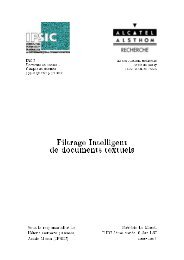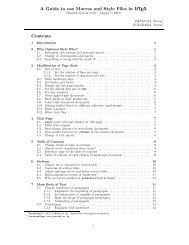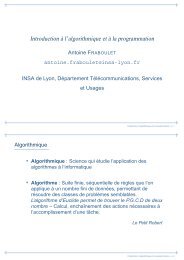Distributed Computing: From Principles to Pervasive Systems
Distributed Computing: From Principles to Pervasive Systems
Distributed Computing: From Principles to Pervasive Systems
Create successful ePaper yourself
Turn your PDF publications into a flip-book with our unique Google optimized e-Paper software.
<strong>Distributed</strong> <strong>Computing</strong>: <strong>From</strong><strong>Principles</strong> <strong>to</strong> <strong>Pervasive</strong> <strong>Systems</strong>Frédéric Le Mouël
Who am I ? – FLM Frédéric Le Mouël (frederic.le-mouel@insa-lyon.fr)– Associate Professor – INSA Lyon– Researcher – INRIA Rhône Alpes– http://perso.citi.insa-lyon.fr/flemouel/ @flemouel Research at CITI Labora<strong>to</strong>ry / INRIA Amazones Team– Middleware, Component- and Service-Oriented Programming andArchitectures, <strong>Pervasive</strong> <strong>Systems</strong>, Ambient Intelligence, Adaptation Teaching at Telecommunication Department– Modeling and Software Engineering, Middleware, Object-OrientedProgramming, Java, Dynamic Web, <strong>Pervasive</strong> <strong>Systems</strong>
How <strong>to</strong> succeed in this lecture ? No mystery: Reading !– Two books– ~5-10 reference publications To acquire– Background– Critical sense
First part: Definitions and Concepts
<strong>Pervasive</strong> ≠ Peer-<strong>to</strong>-Peer ? Different application domains Common aspect:– Both are Highly Dynamic <strong>Systems</strong>– Devices, Data, Applications appearance/removal– Distance is different• <strong>Pervasive</strong> <strong>Systems</strong> ð Proximity• Peer-<strong>to</strong>-Peer <strong>Systems</strong> ð Large-scale
How <strong>to</strong> build such systems ? Common goal:– Building an application respecting user’s needsand adapted and adapting <strong>to</strong> these highlychanging environmentsðWhich are the base blocks on such developmentand runtime lifecycle ?
LifecycleDevelopmentDeploymentRuntimeApplicationMiddlewareHardwareUser’s needs(examples:Information<strong>Systems</strong>,Location<strong>Systems</strong>,etc.)(examples:Models,Dev Toolkits,Architecture,Simula<strong>to</strong>rs,etc)(examples:Devices:PDA, mobilephones,lap<strong>to</strong>ps, etcNetworks:802.11*, etc)<strong>Pervasive</strong> or P2P DynamismSpecificGeneric(reusable)Specific
MiddlewareMiddlewareModelApplicationArchitectureHardwareFrameworkToolkitDesign Development Runtime
Middleware Model, Architecture, Framework and Toolkitconcepts– Transversal concepts (not only linked <strong>to</strong>middleware)ðDetailed in this lecture in terms ofmiddleware for <strong>Distributed</strong> and <strong>Pervasive</strong><strong>Systems</strong>
Definition: Framework “A software framework is a reusable design for asoftware system (or subsystem). This is expressedas a set of abstract classes and the way theirinstances collaborate for a specific type ofsoftware.” [Johnson 1988] “A framework is a set of cooperating classes thatmake up a reusable design for a specific class ofsoftware.” [Gamma 1995] Classes ð System base blocks Specific class of software ð Skele<strong>to</strong>n of applicationfamily
Definition: Toolkit “A <strong>to</strong>olkit is a set of related and reusableclasses designed <strong>to</strong> provide useful, generalpurposefunctionality. An example of a <strong>to</strong>olkitis a set of collection classes for lists,associate tables, stacks and thelike.” [Gamma 1995] Lists, etc ð Implementation of base blocks
Definition: Model “Metamodeling is the construction of a collection of"concepts" (things, terms, etc.) within a certaindomain. A model is an abstraction of phenomena inthe real world, and a metamodel is yet anotherabstraction, highlighting properties of the modelitself.” [Wikipedia, OMG 2001, Schmidt 2006] Abstraction ð Characteristics of the system Phenomena ð Behavior of the system Properties ð Deterministic behavior, guarantees ?
Definition: Architecture “The software architecture of a program orcomputing system is the structure orstructures of the system, which comprisesoftware components, the externally visibleproperties of those components, and therelationships between them.” [Len 2003]
SummaryFrameworkApplication FamilyApplicationArchitectureBusinessCodeComponentService, etc.ModelPredefinedCodeToolkit
Next step Frameworks, <strong>to</strong>olkits, architectures, modelsfor:– <strong>Pervasive</strong> systems– Peer-<strong>to</strong>-peer systems
Bibliography Johnson, R. E. and B. Foote (1988). “Designing reusable classes”.Journal of object-oriented programming 1(2): 22-35 Pree, W. (1994). “Meta patterns - a means for capturing the essentials ofreusable object-oriented design”. in M. Tokoro and R. Pareschi (eds),Springer-Verlag, proceedings of the ECOOP, Bologna, Italy: 150-162 Gamma, E.; Helm, R.; Johnson, R. and Vlissides, J. (1995). “DesignPatterns”. Addison Wesley Professional <strong>Computing</strong> Series. OMG (2001). “Model Driven Architecture (MDA) document”. ArchitectureBoard ORMSC. Len, B.;Clements, P.; Kazman, R. (2003). “Software Architecture InPractice, Second Edition”. Bos<strong>to</strong>n: Addison-Wesley, p. 21-24. Schmidt, D.C. (2006). “Model-Driven Engineering”. IEEE Computer 39(2).
<strong>Pervasive</strong> <strong>Systems</strong>Introduction
New visionfor Information Technologies Working Environment– Before: a virtual environment where you log in,execute applications and then log out– Now: a physical environment where you arealways connected <strong>to</strong> execute tasks
Before:Room full with a computerElectronicNumericalIntegra<strong>to</strong>rand Computer(ENIAC)1946© Computer Science His<strong>to</strong>ry
Now: Room withseveral visible devicesInternetAccess ControlFirewallWired backboneFor example EthernetHome GatewayWireless infrastructureFor example WLANHome ControlHome control networkFor example PowerlinePersonal networkFor example Blue<strong>to</strong>oth
Tomorrow: Everyday lifefull of invisible appliances
Motivation Today– Computers– Internet wired connection Tomorrow– Every object will be smart (Embeddedprocessors + memory)– Wireless connection (802.11*, Blue<strong>to</strong>oth, etc. +Internet New Generation, IPv6)
<strong>Pervasive</strong> Environments [M. Weiser, 1991]– « A new way of thinking about computers in theworld, one that takes in<strong>to</strong> account the naturalhuman environment and allows the computersthemselves <strong>to</strong> vanish in the background »– « The most profound technologies are those thatdisappear . They weave themselves in<strong>to</strong> thefabric of everyday life until they areindistinguishable from it »
<strong>Pervasive</strong> Environments [M. Satyanarayanan, 2001]– « One saturated with computing andcommunication capability, yet so gracefullyintegrated with users that it becomes ‘atechnology that disappears’ »
<strong>Pervasive</strong> Environments [NIST, 2001]– « <strong>Pervasive</strong> computing is a term for the stronglyemerging trend <strong>to</strong>ward: numerous, casuallyaccessible, often invisible computing devices,frequently mobile or embedded in theenvironment, connected <strong>to</strong> an increasinglyubiqui<strong>to</strong>us network infrastructure, composed of awired core and wireless edges »
<strong>Pervasive</strong> Sub-<strong>to</strong>pics Interconnection of 3 technological domains:– Smart Interfaces– <strong>Pervasive</strong> Devices, Embedded <strong>Systems</strong>– Ubiqui<strong>to</strong>us Communication, ConnectivitySmart Interfaces<strong>Pervasive</strong> DevicesEmbedded <strong>Systems</strong>Ubiqui<strong>to</strong>usCommunication
System viewof a <strong>Pervasive</strong> System Adapted from [Saha & Mukherjee, 2003]<strong>Pervasive</strong> System<strong>Distributed</strong>SystemMobile SystemMobilityManagementUbiqui<strong>to</strong>usManagementContextManagement© [Laforest]
Definitions Ubiqui<strong>to</strong>us– Accessible from everywhere Mobile– Which integrates mobile devices Context-awareness– Which takes in<strong>to</strong> account the execution environment <strong>Pervasive</strong>– Which associates ubiqui<strong>to</strong>us, mobility and contextawareness
<strong>Pervasive</strong> System Properties Scalability Invisibility Context-awareness Smartness Pro-action
Scalability Management of a great amount of– Devices– Applications– Users PerformanceExample: Web Server scalable ?Ø Development of systems, middlewares, models,applications that are independent and can resist <strong>to</strong>a high number of devices, users, etc.
Invisibility Transparency for human beings Minimal intervention of human beingsØ Adaptation <strong>to</strong> environment changesØ Self-learning Example: au<strong>to</strong>-configuration of gateway
Context-awareness Virtual representation of the physical environment Perception of changes of the environmentØ Environment modelØ Environment moni<strong>to</strong>ring Examples :– User Profile, Application Meta-data, Self-descriptiveDevices– Temperature, Location Sensors
Smartness Smart = showing mental alertness and calculationand resourcefulness [wordreference.com, Merriam-Webster,dictionary.com] “Intelligent” use of perceived changesØ Reaction and/or anticipation model (rules, etc.)Ø Inference mo<strong>to</strong>r Example: Smart House - Power reduction by switchon/off the lights
Pro-action Ability <strong>to</strong> interact, “disturb” the user in order <strong>to</strong> suggest abetter action! To balance with invisibility !Ø Context, environment evaluationØ Several contexts (past, current, future)Ø Disturbance model <strong>to</strong> evaluate the cost/gain betweenInvisibility/Pro-action Example: Information filtering/classification -> Spam
<strong>Pervasive</strong> <strong>Systems</strong>Middleware
Hardware’s constraints Au<strong>to</strong>nomy ï Battery Limited resources (CPU, memory, screen,etc.)– Power ó/ Battery, energy dissipation– Capacity ï Weight, size Low impact robustness ï Weight, size Low security confidence ï Easy access, lost
Environment’s constraints Mobility / Nomadism– Transmission signal• Connections / disconnections• Variable signal strengthð Interferences, cells scope– Services availability• Different quality of serviceð Devices appearance / removal
Userand Application’s constraints User’s constraints– User Profile– QoS required Application’s constraints– Power demand– S<strong>to</strong>rage demand
System viewof a <strong>Pervasive</strong> System<strong>Pervasive</strong> System<strong>Distributed</strong>SystemMobile SystemMobilityManagementUbiqui<strong>to</strong>usManagementContextManagement
Coda• File system– Hoarding mode (connected)• Loading• Prefetching– Emulating (disconnected)• Local work• Logs– Write disconnected (weakconnection)• Loading• Reconciliation
System viewof a <strong>Pervasive</strong> System<strong>Pervasive</strong> System<strong>Distributed</strong>SystemMobile SystemMobilityManagementUbiqui<strong>to</strong>usManagementContextManagement
Definition [Salber,Dey,Abowd 99]– « Environmental information or context coversinformation that is part of an application’soperating environment and that can be sensedby the application. This typically includes thelocation, identity, activity and state of people,groups and objects. »
Context data 4 axes– User• Profile, preferences, location, etc.– Application• Size, format, encoding, langue, versions, etc.– Hardware• Screen size, resolution, color depth, memory, etc.– Network• Bandwidth, signal strength, etc.
Context modeling 3 approaches– Attribute/Value– CC/PP Extension– On<strong>to</strong>logy
Attribute/Value Pairs Context = pairs (attribute, value)– User= To<strong>to</strong>– Localisation = CITI Pairs are independent+ Easy- Consistency- Poor semantic expressiveness
CC/PP Extensions Composite Capabilities / Preferences Profile (W3C)– Hardware and User– RDF file– Context = Extensions proposal+ Standard- Extensions =>Complex, hard <strong>to</strong> read
CC/PP example:XML file320x20016Mb
On<strong>to</strong>logy Model of– Class– Classes relationships– Instances+ Semantically expressive+ Large-scale environments- Complex, on<strong>to</strong>logy matching
On<strong>to</strong>logy example Exemple CoOL [Strang & al. 03]+49-179-123456736703253307410m90
SynthesisExpressivenessand powerfulEasinessConflictManagementAttribute /Value-+-CC/PP++-On<strong>to</strong>logy+-+
System viewof a <strong>Pervasive</strong> System<strong>Pervasive</strong> System<strong>Distributed</strong>SystemMobile SystemMobilityManagementUbiqui<strong>to</strong>usManagementContextManagement
Ubiqui<strong>to</strong>us Management Ways of accessing everything everywhere 2 steps– Discovery– Communication/Dissemination• Data results• Software itself
Service Discovery Pro<strong>to</strong>cols Service search– Where are the services ?– Where <strong>to</strong> s<strong>to</strong>re this knowledge ?
Service Discovery Pro<strong>to</strong>cols 2 implementation approaches– Service registry: centralized– Flooding: distributed Different search criteria– Location– Semantic– Mobility
Service Registry Organized set of available services Set provided by a dedicated host Examples:– SLP– Jini– Salutation
SLP registry: centralized data Service Location Pro<strong>to</strong>col: Agent based Service Agent: the provided service Direc<strong>to</strong>ry Agent– Registers the SAs in a LDAP registry– Multicast User Agent: the requester of the service– Multicast request
Jini registry: centralized soft Sun Jini: Java based Service provider– Identity and group broadcast– Renew registering Jini registry:– S<strong>to</strong>res RMI interface, proxy <strong>to</strong> service provider– Leasing mechanism, limited lifetime s<strong>to</strong>ring Service requester– Lookup request, receives proxy and location– Direct RMI proxy use
Each host:Salutation registry:neighbours decentralization– S<strong>to</strong>red a subset of available services Service provider:– Registers in local registry– And in neighbours registries Service requester:– Lookup in local registry– Then broadcasts <strong>to</strong> neighbours registries
UPnP: flooding discovery Universal Plug and Play: Industrialconsortium Each host– Available service list– Zero conf (DHCP, au<strong>to</strong>IP, multicast DNS)– Communication (point-<strong>to</strong>-point, streaming)– Au<strong>to</strong>matic discovery• Multicast: XML messages, Arrival ANNOUNCE,Services available OPTIONS
Blue<strong>to</strong>oth registry:geographic service location Each host: SDP server– S<strong>to</strong>red local available services (service record:services attributes, class with unique UUID) Service provider:– Registers in local registry Service requester:– UUID lookup– Broadcast lookup for navigating in<strong>to</strong> neighboursregistries
Service request:Multi-layers clusters: geographicand semantic discovery– Lookup in the closest cluster• Level 1: direct access or same service• Level 2: 2 hops or same category service• Level 3, etc.Clusters niveau 1Clusters niveau 2
Mobile Services Lookup During use, services can move– User mobility– Load balancing 3 accessing approaches– Location server– Poste restante– Repeaters
Location server:Mobile service discovery:location server– S<strong>to</strong>res pairs (service/location)– Each service warns the server of its locationchanges Service requester:– Asks the location server for the service location– Directly accesses <strong>to</strong> the service
Mobile service discovery:Poste restante Static proxy:– As the same service interface– Used as Poste restante for the service– The Service periodically reads and answers itsmessages Service requester:– Asynchronous communication– Send a message <strong>to</strong> the service– Proxy interception
Mobile service discovery:Repeaters Service provider:– Generates a repeater on each host it is leaving– A repeater knows the next location of the service– A repeater forwards the messages <strong>to</strong> the nextservice location Service requester:– Sends its request <strong>to</strong> a service at its last knownlocation Several service moving: Repeaters chain
System viewof a <strong>Pervasive</strong> System<strong>Pervasive</strong> System<strong>Distributed</strong>SystemMobile SystemMobilityManagementAdaptationManagementUbiqui<strong>to</strong>usManagementContextManagementApplicationMiddleware
Adaptation Management Dynamic adaptation Adaptation can focus:– The user interface (close <strong>to</strong> application)– The data– The Services
Data adaptation Data adaptation: modification of data <strong>to</strong>respect the display rules of a target terminal Adaptation location:– On the client (not for light-client)– On the server (heavy-server)– On a active proxy network (load balancing,consistency <strong>to</strong> implement)
Adaptationaccording <strong>to</strong> data type Text source– Format conversion (html -> txt, doc -> pdf…)– Summary– Traduction– Compressing/uncompressing– Vocal synthesis Image source– Format conversion (jpeg -> png)– Modifications of resolution, colours number, depth…– Compressing/uncompressing (e.g. semantic jpeg or rawzip)
Audio sourceAdaptationaccording <strong>to</strong> data type– Format conversion– Textual synthesis or vocal recognition– Compressing/uncompressing (e.g. semantic MP3 or rawzip) Video source– Format conversion (resolution, nb images/sec)– Spatial Decomposition/recomposition (zoom…)– Compressing/uncompressing (e.g. semantic MPEG4 orbrute zip)
Content adaptation opera<strong>to</strong>rs Coding (Wav->MP3) Format (HTML ->WML) Modality replacement (image by descriptive text) Selection (size selection of images) Integration (multi-servers data)
Documents adaptation byWebServices [Berhe, Brunie 2004] WebServices-based adaptation architecture– Local Proxies– Content Proxies– Content Servers– Adaptation Service Proxies– Adaptation Services Reposi<strong>to</strong>ry– Profile Manager
4 profile types:– DocumentDocuments adaptation byWebServices• Physical meta-data (type, size, format…)• S<strong>to</strong>rage meta-data (versions, repartition…)• Semantic meta-data (keywords…)– Client : user and terminal CC/PP• User : language, interests…• Terminal : hardware (screen size, memory...) and software (available,versions,…)– Network• Latency, bandwidth …– Service• WSDL : adaptation type, media type, performance, cost...
Local proxyDocuments adaptation byWebServices– Receives user requests– Calculates the client profile– Sends the request <strong>to</strong> content proxy– Compares the answer profile with the client profile– Deduces an adaptation plan and applies it– Integrates adapted received data– Collaborates with other local proxies for cachemanagement
Adaptation planDocuments adaptation byWebServices– Determines the adaptation constraints: attributesconditions– Determines the adaptation opera<strong>to</strong>rs needed– Selects an optimal adaptation strategy– Looks for adaptation services that can realize the neededadaptation opera<strong>to</strong>rs– Negotiates with the adaptation services (costs,performances)– Uses selected adaptation services
Documents adaptation byWebServices Notion of adaptation path– Sequence of adaptation opera<strong>to</strong>rs that verifiesthe constraints– The path can be balanced by costs,performances… Notion of adaptation graph– When several adaptations can be applied inparallel on a subset of data (eg. image et metadataon images – DICOM format)
Bibliographic references -Content adaptationE. Mory et al. Adaptation de contenu multimédia aux terminaux mobiles.RTSI - ISI n° spécial systèmes d ’information pervasifs n°9, 2004,Hermès: 39-60G. Berhe, L. Brunie, LIRIS Adaptation de contenus multimédia pour lessystèmes d ’information pervasifs RTSI - ISI n° spécial systèmesd ’information pervasifs n°9, 2004, Hermès: 39-60
Services adaptation Services adaptation have generally 3 parts[Cremene 04]:– Modifiable part: the adaptable service– Moni<strong>to</strong>ring part: continuous evaluation of theservice and its context– Control part: definition of reconfiguration orders,according <strong>to</strong> the service logic
ReflexivityAdaptationin reflexive systems– Ability of a system <strong>to</strong> represent itself, <strong>to</strong> moni<strong>to</strong>r itself and<strong>to</strong> act on itself– Meta level that describe the components of a system Introspection– System property allowing <strong>to</strong> know its internal state.Allows <strong>to</strong> reason and take decision about itself Intercession– System property allowing <strong>to</strong> change its behaviour bymodifying its own functionality
Adaptation Adaptation targetsin reflexive systems– Entity (methods, objects, components, services…)– Link between entity (links between base entities and/orbetween base and meta entities)– Set of entities Adaptation moment– Compilation : code generation according <strong>to</strong> meta-entity– Loading : alteration of compiled code or modification ofdependencies in a set of entities– Execution : dynamic access <strong>to</strong> the meta level, by usingproxy, or by the execution platform
RAM [Bouraqadi et al 01] Reflexion for AdaptableMobility Code mobility = non functional aspect, so at metalevel Cluster = unity of mobile code with:– A set of applicative objects– A meta interface for policies of the cluster (migration, …)– A table of instantiated bindings (references <strong>to</strong> otherclusters) Strong code mobility
DynamicTAO:reflexive middleware [Kon et al. 2000] ORB reflexive based onCORBA Set of Component Configura<strong>to</strong>rs– A TAO Configura<strong>to</strong>r maintains middlewarestrategies (concurrency, scheduling…)• Component calls interception -> strategies• Dynamic component load of implementations (evenfor strategies) Component dynamic reconfiguration
Dream : Dynamic REflectiveAsynchronous Middleware [Leclerc et al. 2005] « component-based framework forconstructing, statically or dynamically, resource-aware,configurable message-oriented middleware (MOM) ». Fractal extension (Java based)– Dynamic assembly of components• Primitive components• Composite components– For each component, management interfaces:• BindingControler : components dependencies management• ContentControler: adding and removing components• LifeCycleControler : run, s<strong>to</strong>p components
AeDEN – Software entityadaptation [Le Mouel 2003]ApplicationSpecializationaccording <strong>to</strong> needsNeeds changesExecution behaviourAdaptation strategyActs onAdaptation systemEnvironmentCharacteristicsof environmentVariationschanges
AeDEN - entity Entity = software conception unity– Abstract and specializable– A functionality A entity– A service A specialized entity 3 aspects:– AInteraction (communication with other entities)– AImplementation (business : expected treatments)– AState (internal state of the business part) Different implementation available for each aspect
AeDEN - entity Abstract entity + possible specializations
AeDEN – Adaptive entity Entity + Adaptation entity– Adaptations by introspection and intercession
AeDEN - introspection andintercession Each entity has the following methods:– getInteraction(), setInteraction()– getImplementation(), setImplementation()– getState(), setState() Each adaptive entity has the following methods:– getFunctionalInteraction(), setFunctionalInteraction()– getFunctionalImplementation(),setFunctionalImplementation()– getFunctionalState(), setFunctionalState()
AeDEN - Adaptive andreactive entity Adaptation entity + reaction entity linked <strong>to</strong> anotification service
Entité fonctionnelle (In, Im, St)Im : algo de compression GIFAeDEN – Strategy example Adaptation strategy for the transmission ofcompressed picturesBande passante JPEG75%Bande passante >Xadaptation d’implantationJPEG75%->GIFEntité fonctionnelle (It, Im’, St’)Im’ : algo compression JPEGSt’ : taux qualité 75%Bande passante JPEG50%Bande passante >Yadaptation d’implantationJPEG50%->JPEG75%Entité fonctionnelle (It, Im’,St’’)Im’ : algo compression JPEGSt’’ : taux qualité 50%
Adaptation conclusion General needs [Le Mouel 2003]:– Genericity : use by different kind of applications– Modularity : Splitting and decorrelation– Context-aware– Evolution : integration of new technologies andnew functionalities– Dynamicity : reaction <strong>to</strong> changes withouts<strong>to</strong>pping the system– Efficiency : performance and stability
Bibliographic references -Adaptation servicesM. Cremene et al. « Adaptation dynamique de services », Decor ’2004, Grenoble, oc<strong>to</strong>bre2004, pp 53-64CAAD : T. Chaari, F. Laforest, A. Celentano design of context-aware applications basedon web services Rapport de recherche LIRIS, oc<strong>to</strong>bre 2004 - RR-2004-033RAM : N.M.N. Bouraqadi-Saadani et al. « A reflexive infrastructure for coarse grainedstrong mobility and its <strong>to</strong>ol-based implementation. » Int. Workshop on experiences withreflexive systems. Sept. 2001DynamicTAO : F. Kon et al. « Moni<strong>to</strong>ring, security and dynamic configuration with thedynamicTAO reflective ORB » Middleware 2000AeDEN : F. Le Mouël « Environnement adaptatif d’exécution distribuée d’applicationsdans un contexte mobile » mémoire de thèse de doc<strong>to</strong>rat en informatique, UniversitéRennes I, 1er décembre 2003M. Leclercq, V. Quma, J.-B. Stefani, DREAM: A Component Framework for ConstructingResource-Aware, Configurable Middleware, IEEE distributed systems online, vol. 6, no. 9,September 2005
Synthesis Roadmap <strong>to</strong> build a <strong>Pervasive</strong> System – Questions?– Which kind of functionalities of a classic distributedsystem do I need (load balancing, fault <strong>to</strong>lerance, etc) ?Can I reuse one, or do I have <strong>to</strong> plan <strong>to</strong> redevelop someof these functionalities ?– How do I model my context ? What do I have <strong>to</strong> includein my context ?– What are the changes expected in my system ? Whereand how do I have <strong>to</strong> adapt <strong>to</strong> these changes ?– What are the middleware frameworks and <strong>to</strong>olkitsavailable <strong>to</strong> reach these goals ?


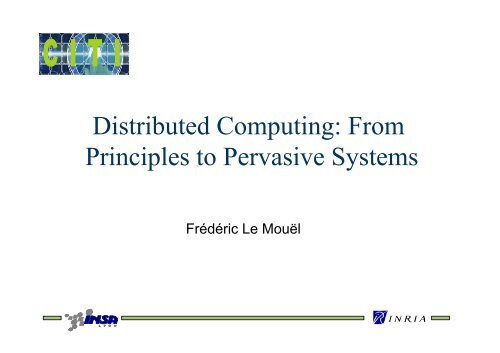
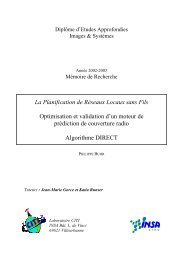
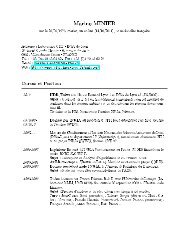

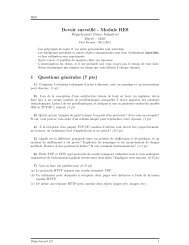

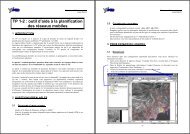
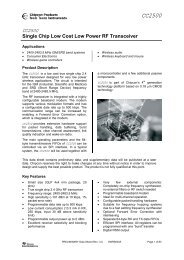
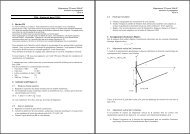
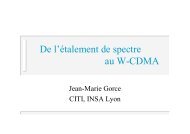
![td-res-4 [Compatibility Mode]](https://img.yumpu.com/45826987/1/184x260/td-res-4-compatibility-mode.jpg?quality=85)
